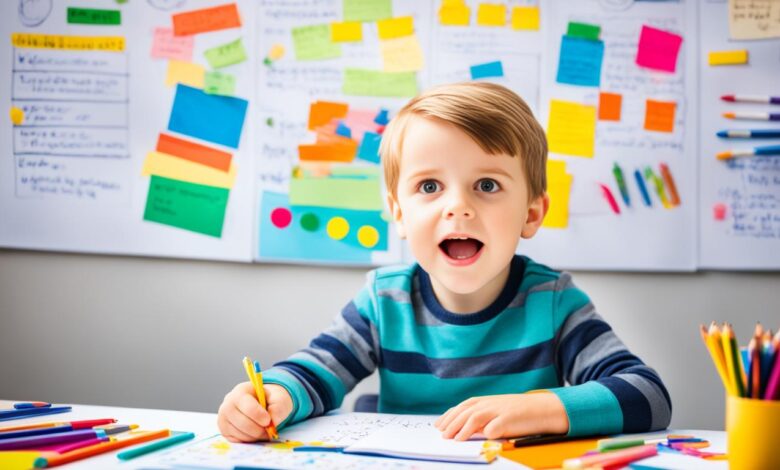ADHD Behavior Management Planning for Kids

In the kitchen, you notice hurried footsteps. You see your child, full of emotions and energy. They are talented and brave, but they face challenges. ADHD affects nearly 6.1 million U.S. children and their families. It turns simple things into big hurdles. ADHD Behavior Management is not just a plan. It’s a way to show patience, understanding, and love to your child.
Looking for ways to handle ADHD behavior? You’re not alone. Every part of the planner is a step towards finding what works. It’s a journey to finding peace and success for your child. Together, we’ll find strategies that fit your child’s unique personality. We’ll make a plan that celebrates their wins and recognizes their efforts.
Starting the journey to help your child reach their potential begins now. It includes structure, empathy, and proven methods. Our goal is to boost their skills, not change who they are. Join me, and let’s navigate this path of challenges and achievements. Each step we take is important in their incredible journey.
Understanding ADHD and Its Impact on Child Behavior
Attention-Deficit/Hyperactivity Disorder (ADHD) changes how a child develops behaviorally and meets daily challenges. Unlike just focusing on inattention, hyperactivity, and impulsivity, ADHD touches many parts of life. This includes social and school settings, making managing it tricky. Establishing a plan for ADHD behavior considers these various issues.

For those caring for ADHD kids, knowing these obstacles is key. This knowledge helps in creating effective strategies for ADHD behavior management. Kids with ADHD often get wrongly labeled as troublemakers. This is not because they choose to disrupt, but because their needs differ from what school typically requires.
Recognizing this is crucial for providing behavioral therapy for kids with ADHD. Therapy aims to see the world through the child’s eyes. It creates support tailored to their personal experiences. Medication plays a role in managing ADHD, but adjusting behavior with therapy is also important. It provides a strong support foundation.
Understanding a child’s perspective is vital for managing ADHD effectively. It’s about more than just success in development. It also helps prevent other issues related to this complex brain condition.
Key Strategies for ADHD Behavior Management
Effectively managing ADHD behavior needs a careful plan that matches the child’s needs. We’ll cover several key strategies and interventions. These can really help bring about positive changes for kids with ADHD.
Creating Structure in Daily Routines
Establishing a structured daily routine is the first step. It’s crucial for children with ADHD. Knowing what comes next reduces their anxiety and disruptive behaviors.
A schedule should cover meal times, homework, play, and rest. This helps create a stable setting that boosts focus and behavior. Tools like planners and checklists can help kids manage their tasks better.
Positive Reinforcement Techniques
Positive reinforcement is vital. It rewards good behaviors, encouraging them to happen more often. A reward system should match the child’s interests to boost their motivation.
These systems can use points, praise, or gifts related to specific behaviors. This creates a positive, achievement-filled atmosphere.
Behavioral Therapy for Kids with ADHD
Specialized therapy is often needed for kids with ADHD. It focuses on improving social skills and managing disruptive behaviors. Through feedback, children learn about their behavior’s impacts.
Learning how to handle frustration and develop patience is key. These skills are crucial for dealing with the challenges ADHD brings.

To better understand diverse strategies, let’s look at common interventions:
| Intervention Type | Description | Expected Outcome |
|---|---|---|
| Structured Routines | Implementing a fixed daily schedule with consistent expectations. | Increased predictability and reduced anxiety levels, leading to better focus and organization. |
| Reward Systems | Rewarding positive behavior with tokens, praise, or activities. | Strengthened positive behavior patterns and heightened motivation. |
| Behavioral Therapy | Regular sessions with a therapist to develop coping strategies and social skills. | Improved social interactions and ability to manage impulsive behavior. |
Different interventions each have a key role in helping a child with ADHD grow. A customized plan using these strategies is usually the best way to improve behavior. It supports success in school and with friends.
ADHD Behavior Management Planning For Your Child
Making an ADHD Behavior Management Plan just for your child can really make daily life better. It offers a routine that kids with ADHD can count on. This boosts their motivation by involving them in making the plan. Help for managing ADHD behavior uses a team approach where therapy is key. Let’s see how a tailored behavior plan can help your child make strides.
Developing a Personalized ADHD Behavior Plan
Creating a behavior management plan for ADHD means thinking about what makes your child unique. Including your child in this process lays a foundation for an effective and motivating plan. Using things like reward systems and visual cues can provide constant encouragement and goal reminders.
Involving Educators in the ADHD Management Process
Educational settings play a big role in managing ADHD effectively. Working together with teachers means efforts at home and school support each other. Such teamwork is crucial for applying consistent behavior strategies and catering to each child’s special needs in school.
Tools and Resources for Parents and Caregivers
Help for managing ADHD behavior is out there for parents. Methods like token economies, visual schedules, and behavioral contracts can aid in providing needed structure for a child. These tools, when used right, offer strategies fitting a child’s age and allow for easy monitoring of progress.
| Resource | Description | Benefits for ADHD |
|---|---|---|
| Token Economies | Systems that reward children with tokens for positive behavior | Encourages consistent good behavior and provides immediate reinforcement |
| Visual Schedules | Charts that outline daily tasks and activities, promoting organization | Helps children understand and manage their daily routines effectively |
| Behavioral Contracts | Written agreements between the child and caregiver on expectations | Fosters commitment and responsibility for their actions and goals |
In conclusion, ADHD Behavior Management Planning For Your Child involves customized plans, active participation, and the right tools. From behavioral therapy for kids with ADHD to specific behavior strategies, each part plays a role in fully supporting kids with ADHD to do their best in school and life.
Interventions and Support: Home and School Collaboration
Creating a developing ADHD behavior plan needs close work between home and school. It helps keep support and changes for a child with ADHD consistent. Parents and educators work together, looking for what causes issues in both places and making needed changes. This teamwork is key to creating behavioral interventions for ADHD child that work well in both home and school.
Strong communication is the core of this team effort. Parents provide valuable insights from home, showing patterns that help shape the school’s approach. On the other hand, schools share how the child does with certain strategies, helping parents at home. This back-and-forth sharing makes behavior plans better and more suited to the child’s needs.
In schools, having clear plans helps teachers support the child’s needs better. Plans might include more breaks, easier work, or quiet places to help with stress. These steps lower class disruptions and make the child feel more included and successful.
This approach helps the child move smoothly between home and school. It boosts their school work, friendships, and happiness. By using behavioral interventions for ADHD child at both home and school, we make schooling more welcoming and effective for them.
To know if these interventions work well, we must regularly check and tweak them. We review how the child reacts to different situations, their school progress, and their emotional growth. Keeping an eye on these ensures the behavioral interventions for ADHD child meet the child’s changing needs. This helps them keep improving and adapting positively.
In the end, making a developing ADHD behavior plan is a team effort. It needs the strength, patience, and creativity of both parents and teachers. When these groups work together with purpose, they build an environment where children with ADHD can do well in school and in life.
Conclusion
Helping a child with ADHD is at the core of creating a ADHD Behavior Management Planning For Your Child. It’s not just about rules. It’s a special plan designed to meet the complex needs of kids with ADHD. Making and following these plans helps overcome daily hurdles and leads to success in school and behavior.
By using effective strategies for ADHD behavior management, we support the child’s strengths and help with their struggles. It’s crucial to include teachers in this plan. This ensures efforts are united at home and school, creating a steady and understanding space for the child to do well.
The true measure of these plans is in appreciating each child’s distinct path. By applying proven strategies and adding personal touches to their daily lives, we set the stage for betterment. This isn’t just about improving conduct or grades but boosting their confidence and growth too. Managing ADHD is a combined effort, aiming for a clearer, more successful, and happier path for our kids.






